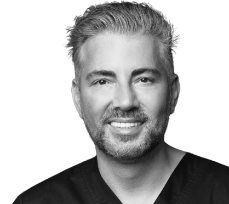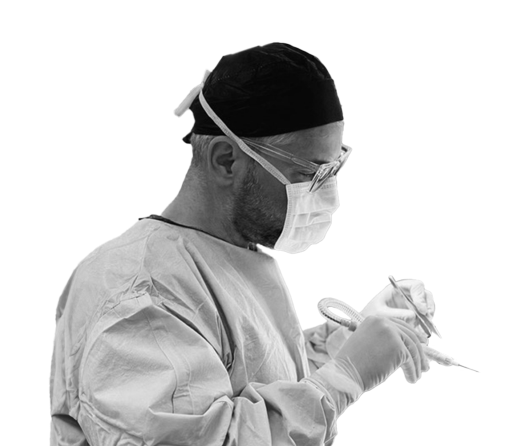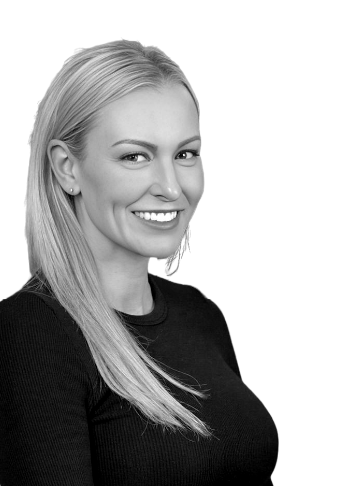Australia’s registered plastic surgeon with experience in:
- Breast Augmentation Mammoplasty & Recovery
- Complicated Breast Revision Surgery & Internal Bra System
- Tuberous Breasts & Breast Asymmetry Corrections
- Comprehensive understanding in Fat Grafting Technique
The incidence of this condition has dropped from 35% down to 5% in most international studies. Dr Tavakoli uses a super sterile technique to insert lightly textured Mentor implants in mostly Dual Pocket. This helps reduce the incidence of capsular contracture.
It is not fully understood the reason for this occurrence of this condition. Capsular hardening or contracture is more common in certain ethnic groups such as Asians and Africans. It can however affect any racial group. Theories range from Biofilm related to bacteria Staph Epiderdimis to serum production as a result of body’s reaction to the implant covering.
The hardening is caused by excessive scar tissue forming around the implants. It can occur as early as 6 weeks after surgery and as late as 10 years. The best way of preventing this is to massage the augmented breasts in the postoperative period so that the capsule forms softly around the implant. The breast hardening process or capsular contracture can have both and pain implications.
The capsulectomy operation removes the hard capsule and the new implants are inserted in a fresh pocket preferably behind the pectoralis muscle.
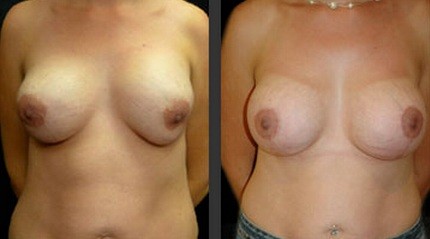
Bilateral Implant Exchange for severe Capsular contracture and mastopexy (breast lift).
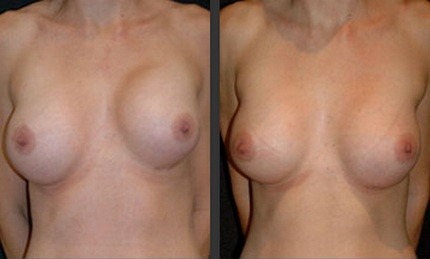
Bilateral Implant Exchange for severe Capsular contracture and mastopexy (breast lift).
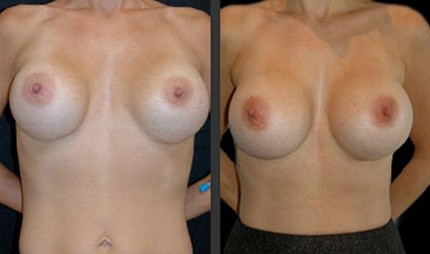
Change of Implant Pocket.
Disclaimer: The outcomes shown are only relevant for this patient and do not necessarily reflect the results other patients may experience, as results may vary due to many factors including the individual’s genetics, diet and exercise.
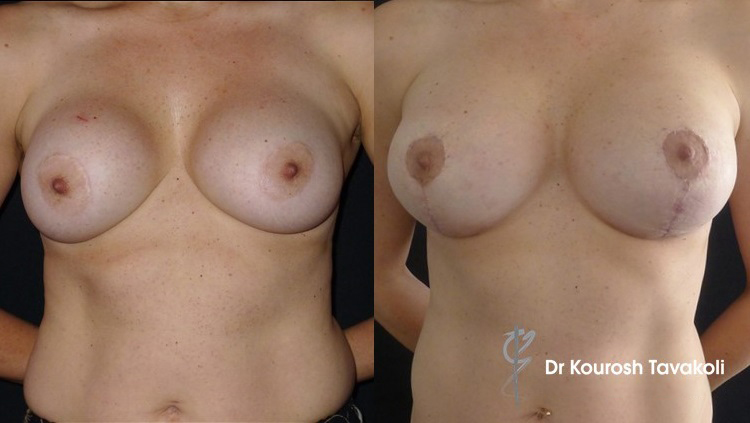
Case Study 1: 43yo female, removal of implants, followed by bilateral breast reduction mammoplasty & lift using CPG Mentor 445cc-332, anatomical (teardrop) implants.
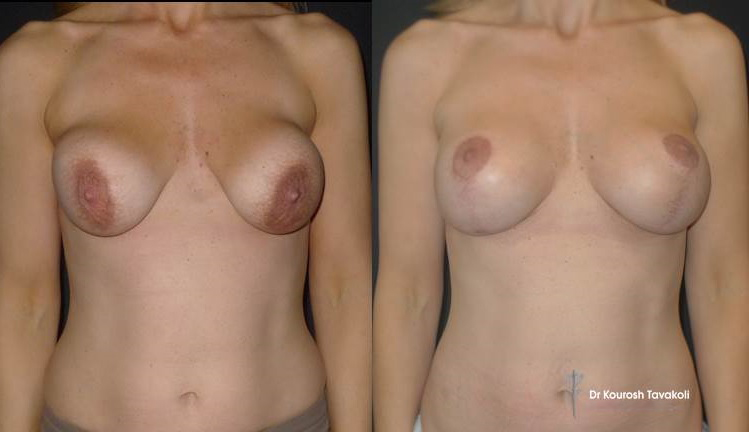
Case Study 2: Bilateral re-augmentation to correct capsular contracture and change of pocket from subglandular to submuscular. Bilateral mastopexy was performed to remove excess skin and reposition and resize the areola.
Disclaimer: The outcomes shown are only relevant for this patient and do not necessarily reflect the results other patients may experience, as results may vary due to many factors including the individual’s genetics, diet and exercise.

Fat grafting (35mL) to cleavage to correct rippling of implants. Implants removed and replaced with Mentor CPG 332-350cc anatomical (teardrop), tall height, moderate plus projection, anatomical (teardrop) implants placed in a dual plane pocket
Disclaimer: The outcomes shown are only relevant for this patient and do not necessarily reflect the results other patients may experience, as results may vary due to many factors including the individual’s genetics, diet and exercise.
Excessive cleavage gap between breasts creating undesirable breasts. This condition usually arises from poor choice of implant and inadequate submuscular dissection.
By further dissection and appropriate use of a broader based implant this condition can be improved. Please note that some women are prone to having this issue as a result of the poor curvature of their chest wall.
Case Study: 25 yo old female, 350cc High profile smooth round gel implants with excessive cleavage gap, Dr Tavakoli up-sized to 485cc High Profile anatomical (teardrop) silicone gel implants with fat grafting to the sternum.
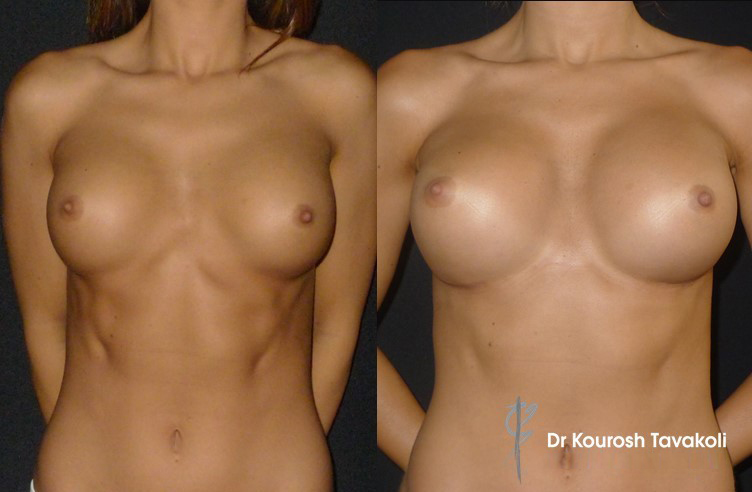
Excessive Cleavage Cap.
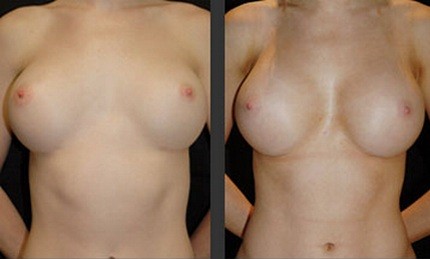
Excessive Cleavage Cap.
Disclaimer: The outcomes shown are only relevant for this patient and do not necessarily reflect the results other patients may experience, as results may vary due to many factors including the individual’s genetics, diet and exercise.
Symmastia is a condition is described where there is no cleavage or very tight cleavage. Patients can rarely be born with this condition (congenital) or commonly acquire it after breast augmentation (mammoplasty).
Acquired Symmastia
Grade 1 tenting: Internal Bra
Grade 2 kissing: Internal Bra +/- ADM
Grade 3 kissing & tenting: 2 stage reconstruction
Risk factors:
-Narrow chested patients & cleavage webbing
-Overdissection of pocket medially
-Use of wide based implant typically
-Usually moderate projecting round implant
-Overuse of postoperative bra
If apparent immediately after breast augmentation (mammoplasty), it has occurred as a result of over-dissection centrally and/or use of very large based implant so that the implants are left too close in the middle. It can also develop months later but overzealous use of “push-up” bras creating thinning of tissue centrally.
Surgical treatment is possible but needs complex re-adjustment of the pockets using permanent suture technique and smaller size implants with narrower base.
In moderate to severe cases if the implants are submuscular the choices are either to suture down the tissues centrally with permanent sutures and dissect the pocket laterally so the implants have room to shift outwards. If the implants are subglandular the implants need to be placed in a new submuscular pocket.
In severe cases Dr Tavakoli prefers the 2 stage technique. The implants have to be removed for 6-12 months and replaced after pocket healing has taken place.
Post operatively ALL patients need to wear a special bra for 3 months with no activity.
Congenital Symmastia:
This is a rare condition. Patients present with excessive breast tissue in the midline without a discernible cleavage line adhered to the bony sternum. The midline feels spongy and there is no apparent clefting. This means the congenital symmastia patients have no cleavage demarcation boundaries.
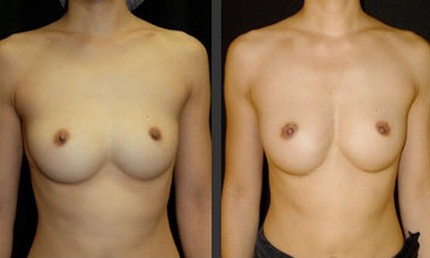
Correction of Congenital Symmastia.
Acquired Symmastia: Case Studies
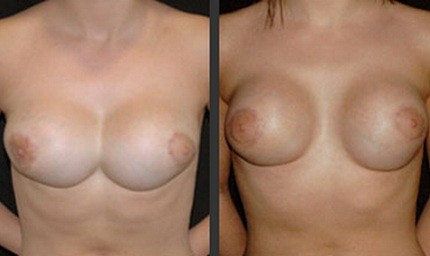
Correction of Symmastia using suture technique.
Disclaimer: The outcomes shown are only relevant for this patient and do not necessarily reflect the results other patients may experience, as results may vary due to many factors including the individual’s genetics, diet and exercise.
This is a condition where the implant and the native breast are in completely different anatomical (teardrop) levels. Routine subpectoral mammary augmentation in women with a small breast lower pole deficiency may lead to unwanted late results with the appearance of a double-bubble deformity. The surgical correction is complex and requires the need for a series of a. excision of breast tissue, b. pocket adjustment or capsulorrhaphy and c. exchange of implants or any combination of the above.
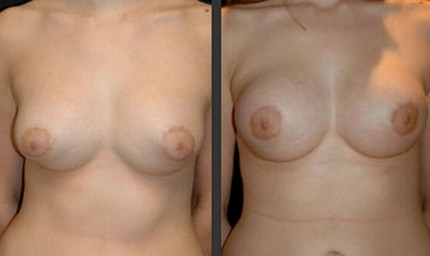
Correction of “Double-Bubble” syndrome.
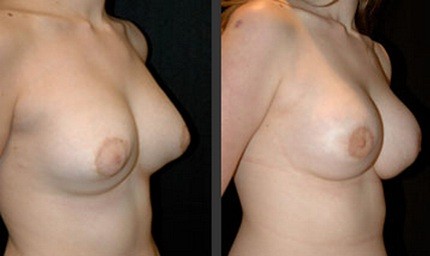
Correction of “Double-Bubble” syndrome.
31yo female, 3 previous surgeries by another surgeon resulting in Double Bubble and rippling. Dr Tavakoli sutured down the breast pocket and complex Double Bubble repair, and removal and replacement of breast implants with Lolly-pop lift using 480cc Ultra High Profile silicone gel textured round implants placed in Dual Plane pocket, type 2. Patient photographed 4 weeks post op.
Disclaimer: The outcomes shown are only relevant for this patient and do not necessarily reflect the results other patients may experience, as results may vary due to many factors including the individual’s genetics, diet and exercise.
There are many reasons why one would opt for change of implant pocket.
- A. Rippling and implant edge visibility are hard to get rid of. One way is for the patient to put a small amount of weight and increase the padding around her breasts. Exchange of implant to smooth high filled implant &/or going behind the muscle also can be very helpful manoeuvres. Fat grafting is also a possible solution.
- B. Placing the implant behind the pectoralis muscle can create an issue namely “winking”. In most patients this is not a major issue but in some women with strong muscles may find this undesirable. Dr Tavakoli normally recommends no surgery for this condition, but some may want to opt to have the implant placed in front of the muscle.
Exchange of implants
For size issues (usually seeking a bigger cup size) or content (usually saline to gel).
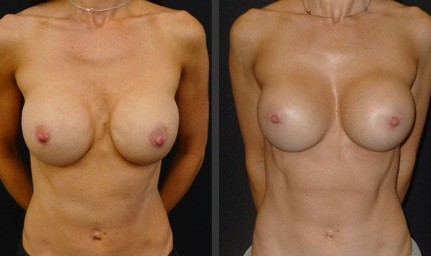
Case Study: 33yo, 2 pregnancies
Implant removed – Mentor 295cc round silicone gel in a sub glandular pocket.
Disclaimer: The outcomes shown are only relevant for this patient and do not necessarily reflect the results other patients may experience, as results may vary due to many factors including the individual’s genetics, diet and exercise.
This condition is a form of implant migration. Although can be seen with all types of augmentation (mammoplasty) it is more common with smooth implants.
The treatment is very complicated and involves pocket repair and exchange with polyurethane coated implants.
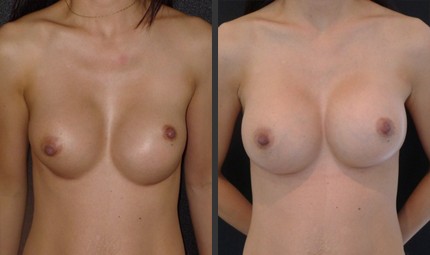
Breast implant bottoming out.
Disclaimer: The outcomes shown are only relevant for this patient and do not necessarily reflect the results other patients may experience, as results may vary due to many factors including the individual’s genetics, diet and exercise.
Plastic Surgeon Dr Tavakoli’s carries out complex corrective breast augmentation mammoplasty surgery on patients Mindy B and Lauren G who need a revision post surgeries performed in Thailand and Malaysia.
MEDICAL TOURISM ALERT: Travelling overseas for cosmetic surgery just to save money can lead to poor outcomes, often with avoidable complications, little or no recourse to return for additional revisional treatment, and sometimes resulting in significant complications.
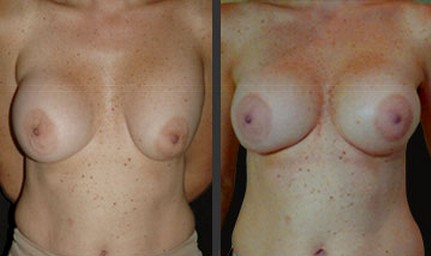
Breast correction after implant rupture and capsulization. Original surgery done overseas in 2006, 26 yr. old female presented to Dr Tavakoli unhappy with the shape of her breasts following a severe accident. Dr Tavakoli performed a capsulectomy/removal of ruptured gel implant on the left breast. New sub muscular pocket created, 400cc HP round mentor textured implants inserted.
Disclaimer: The outcomes shown are only relevant for this patient and do not necessarily reflect the results other patients may experience, as results may vary due to many factors including the individual’s genetics, diet and exercise.
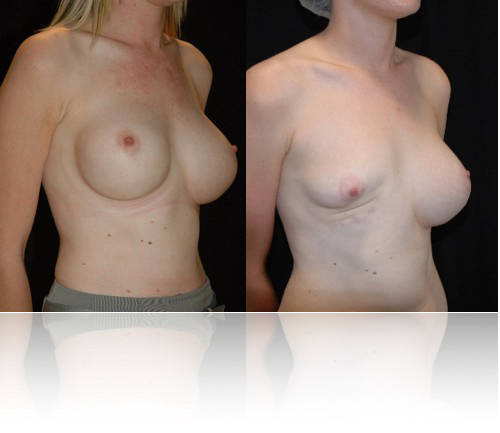
Breast implant infections are extremely rare but they can unfortunately occur. Dr Tavakoli has successfully performed reconstruction following this condition in the past.
Disclaimer: The outcomes shown are only relevant for this patient and do not necessarily reflect the results other patients may experience, as results may vary due to many factors including the individual’s genetics, diet and exercise.
Scar revision may be needed for poor scarring such as Hypertrophic scar or Keloid. Prior to scar revision Dr Tavakoli recommends the FRAXEL laser technology to improve the quality of the scar and /or a course of intralesional steroid injections. Failing the latter then formal surgery on the scar by re-cutting and suturing can improve the quality of the scar.
Dr K TAVAKOLI, FRACS Plastic Surgeon, MED0001166578, regularly performs breast implant corrective surgery in Sydney, Australia. To book an appointment call 1300 368 107 or fill in the form on the right.
Any surgical or invasive procedure carries risks. Before proceeding, you should seek a second opinion from an appropriately qualified health practitioner.
